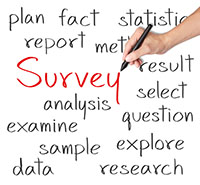Scanning the Horizon: Internal and External Scanning
The Internal Environmental Scan is a review of SUA and AAA resources, current strategies, performance, strengths, weaknesses, opportunities, and threats. It results in a description of the internal environment of the State and Area Agencies on Aging.
Resources may include people; funding; information technology (IT) capability, such as client data systems; competencies; and culture. The Resource Review includes constraints upon the use of resources, such as lack of flexibility; personnel rules; insufficient IT capability, etc.
The Strategy Review includes the overall strategy of the state agency on aging (and/or the Older Americans Act unit), the agency's business processes, and functional strategies. The Performance Review will include the historical performance of the agency, current results, indicators, and scorecards.
Key Considerations
- Current SUA/AAA priorities and initiatives
- IT infrastructure capabilities and capacities
- Staff capabilities and competencies
- Agency organizational structure and operation
Questions Specific to This Decision Point
- Does the agency's priorities and initiatives need to be modified or changed?
- What is the staff attitude toward change?
- Does the current agency staff have the right capabilities and competencies for the priorities and initiatives that will be pursued during the next 3-4 years?
- Do the agency's existing information systems have the capacity to support agency priorities, initiatives, and quality assurance, monitoring and assessment, planning and evaluation functions?
- What are the agency strengths?What are the agency weaknesses?
Who Participates?
- Internal stakeholders
- Program participants
- AAAs
- SUAs
- Governor's Office
- Medicaid Agency
- Providers/Provider Associations
- Tribal Organizations
One option is to form narrowly focused Work Groups with a limited number of meetings which include a high intensity of involvement by the stakeholder representatives.
Data & Statistics: Aging Integrated Database (AGID)
The AGing Integrated Database (AGID) system is an on-line query system that provides access to ACL-related program performance results, surveys and other data files. The purpose of the system is to:
- Provide a single, user friendly source for a variety of information on ACL supportive services and comprehensive systems of care for older adults and their caregivers, and people with disabilities of all ages
- Allow users to quickly produce tables, maps, and other summary information from ACL-related data files and surveys, supplemented by Census-based population and demographic charactertistics
- Provide users full access to results from national surveys of recipients of Older Americans Act services and ACL Special Tabulations produced by the Census Bureau
Additional Resources
An External Environmental Scan consists of identifying and evaluating the impact of key external forces and emerging trends within the broader environment in which the state aging network operates.
Key Considerations
- Priorities and initiatives of funding sources
- Plans and initiatives of other state and local agencies
- Plans and initiatives of multiple Area Agencies on Aging
- Challenges and opportunities
- Collaborative and competitive forces
Trends and Demographics
An understanding of the state's future demographics is key to developing an effective and relevant state plan. Information bearing on demographics helps guide what, how, where, and to whom services are provided. Demographic trends and projections help determine how funds will be allocated throughout the state. Assessing demographics will help guide future directions of the Aging Network in meeting needs of America's aging baby boomers.
Questions Specific to Decision Point
- Who comprises the population of older adults and how will the disability community be included?
- Today?
- In the next three to four years?
- In five to ten years?
- What do they want?
- Are the wants changing?
- What are their expectations?
- Are the expectations changing?
- What is the status of the service system?
- What's working?
- What's not?
- Is there an adequate number of providers?
- Are enough units of service available?
- Do providers have the capacity to provide the additional units?
- Are the right services available?
- Do the existing providers have the capacity to produce the "right" services?
- How do the current SUA/AAA priorities and initiatives relate to those of the Administration on Aging and other funders?
- How do the current SUA priorities and initiatives relate to those of the area agencies on aging?
- What are the economic trends?
- What are the political trends?
- Who are the key resource controllers?
- Clients/customers, regulators, payers, policymakers?
- What are the social trends?
- What assets can be tapped?
- What is the availability of appropriate, affordable, and safe housing?
- What are the challenges?
- What are the threats to independence, well-being, and financial security?
- What are the opportunities?
Who Participates?
It is important to consider who to invite to participate in this activity. Below is a list of participants to consider. Each will bring a different perspective to the process. For example, private citizens who are not program participants bring a perspective of family caregivers, private pay, and the viewpoint of the larger community. This may be especially important when considering the development of Aging and Disability Resource Centers.
Each state needs to fine-tune their own list. Stakeholders may not always be appropriate depending upon the specific planning approach the agency is using. No hard and fast rules exist. In some cases, states may need to add categories of stakeholders to support their planning approach.
- Citizens
- Program Participants
- Advocates
- AAAs
- Providers
- Provider Associations
- Tribal Organizations
- Governor's Office
- State legislature
- Funders (United Way, Foundations, etc)
- Other State Agencies serving older individuals
- Elder Rights Professionals (long-term care ombudsmen, adult protective services, legal services providers, etc.)
- Medicaid
- Health
- Mental health
- Social services
- Insurance
- Attorney General
- Disability Agencies
- Transportation
- Housing
Key Decision Points
- Mission & Values
- Environmental Scanning
- Issues Identification
- Needs Identification
- Assets Identification
- Barriers Identification
- Goals & Objectives
- Outcomes & Performance Measurement
- The Plan


